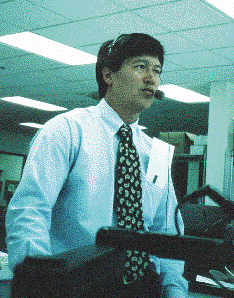GOLDSEA | ASIAMS.NET | ASIAN AMERICAN PERSONALITIES
REMOTE POSSIBILITIES
PAGE 2 of 3
 ulun Wang was born April 9, 1960 in Boston while his father was doing post-doctoral work at MIT. The Wang family travelled around the world in those early years, following Dad on his professorial career--from Michigan to Ohio and onto Taiwan, eventually settling in Berkeley when Yulun was 5.
ulun Wang was born April 9, 1960 in Boston while his father was doing post-doctoral work at MIT. The Wang family travelled around the world in those early years, following Dad on his professorial career--from Michigan to Ohio and onto Taiwan, eventually settling in Berkeley when Yulun was 5.
| "And, of course, there's a period of time when every guy wants to be an astronaut." |
Varied interests played part in a psychedelic-'70s childhood. Though very much a youngster in Berkely's hippie heyday, Wang remembers distinctly the energy of the day. He and his older brother Gene, the current CEO of Computer Motion, shared a room that they decorated with fluorescent lights, groovy posters and incense.
"My folks were fine with it," says Wang. "They're very progressive thinkers, letting us explore what we wanted to explore. They would rather educate us to make the right decisions."
Walking down Telegraph Avenue, Wang recalls the hippies hanging out, spreading their love and preaching a "freedom of the spirit type of attitude." Wang experienced it, but didn't get caught up. He concentrated on school, always pulling straight A's and playing lots of sports, mainly surfing. The ocean has always held a great allure for Wang, and it has influenced a number of his choices later in life. But he couldn't decide which of his multiple interests should be his focus.
"My father said, 'Why don't you be an engineer, because all of these different disciplines need engineering help.' That's how I remember making a conscious decision to go into engineering," says Wang. UC Santa Barbara's well-respected engineering school caught his eye, as did the ocean.
"I believe in nice environments," says Wang. "I surf. I was single. UCSB fit my objectives of a great education and a great way of life, as it turns out, to enjoy college and afterwards."
Freshman and sophomore years were the grind years when engineering students learn the basics of the discipline. It wasn't until junior year that Wang started to enjoy it. He began to see engineering as a truly creative discipline. "You're trying to build and create things out of stuff that doesn't yet exist."
His interest was piqued by mechanisms. NASA's work with shuttle arms and Mars rovers, underwater submersibles that explored hydrothermal vents off continental ridges--Wang discovered how engineering could tap into his oceanic interests. But that was only the beginning of his interest with robotics. UCSB had no courses in robotics for undergraduates.
"I finished my degree in electrical engineering and went straight to a masters degree where I specialized in instrumentation. It's basically the theory behind electronic circuit design." It gave him an advanced ability to build things which, as an engineer, is really what he wanted to do.
"I like seeing results as opposed to building the new silicon chip and figuring how to create the different necessary layers in order to get it functioning properly. I like seeing visual stimuli," says Wang.

Wang demonstrates the AESOP 2000 voice command controlled robot.
In 1985, Wang continued his education at Scripps Institute of Oceanography, one of the top two oceanographic institutions in the country. He studied underwater robotics, still enamored with the robots he'd read about that explored the hydrothermal vents. These vents, Wang passionately explains, are the only ecosystems on earth whose energy is not derived from the sun but from the interior of the earth. The robots submerge to environments too deep and pressurized for humans to study. He was fascinated with the ability to provide people with capabilities to explore where we previously could not. But the more he learned about the business of oceanography, the more he realized it wasn't for him.
"It took me a year to figure a few things out," says Wang. "One, if you're doing deep sea exploration, it means you're up on the surface, way out in the middle of nowhere, bobbing up and down in this ship. That's not that fun or glamorous from my perspective.
"And I learned that completing my education at Scripps would focus my life towards academics and I wasn't clear at that point in my life that I wanted to make that decision. I always had an industrial, entrepreneurial bent."
Just about that time, UCSB won a $12 million National Science Foundation grant to start up a robotics center in microelectronics--to apply robotics to semiconductor manufacturing.
That was the year the stars aligned for Wang.
He called his former adviser who was given charge of the operation. Wang was one of the first students let in to the Center for Robotics Systems and Microelectronics. He knew how to design circuits and started designing robotic control systems--the brains of the beasts.
He finished his Ph.D. at the Center for Robotics in 1988, during which time he developed the 3-D circuit architecture for advanced robot control that was the basis for Computer Motion. He was the first person to finish the Ph.D. program at the center, and from '88 to '89, Wang taught at UCSB with every intention of getting his own business off the ground. He considers those years a source of income for Computer Motion. He learned how to write the grants that got him the intitial money. PAGE 3
CONTACT US
|
ADVERTISING INFO
© 1996-2013 Asian Media Group Inc
No part of the contents of this site may be reproduced without prior written permission.
